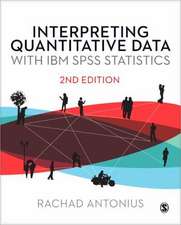Community-Based Qualitative Research: Approaches for Education and the Social Sciences
Autor Laura Ruth Johnsonen Limba Engleză Paperback – 26 mai 2016
Preț: 516.93 lei
Preț vechi: 698.54 lei
-26% Nou
98.91€ • 103.55$ • 81.85£
Carte disponibilă
Livrare economică 17-31 martie
Livrare express 28 februarie-06 martie pentru 25.66 lei
Specificații
ISBN-10: 1483351688
Pagini: 208
Dimensiuni: 187 x 232 x 15 mm
Greutate: 0.36 kg
Ediția:1
Editura: SAGE Publications
Colecția Sage Publications, Inc
Locul publicării:Thousand Oaks, United States
Recenzii
This book is a very concise, useful and practical contribution to the field of community education. It is an excellent starting point for launching researchers into addressing community-based problems.
Community-Based Qualitative Research: Approaches for Education and the Social Sciences provides a unique perspective of collaborating on research projects with the community. Grappling with current issues, this book provides real-world experiences to help conquer these problems.
In many overview courses of qualitative research methods, community-based research gets little air time. This text helps fill in the knowledge and experience gaps for faculty and students so they can construct their own community-based class projects in a more thoughtful and reciprocal manner. It also has great learning activities that can be used in the classroom.
Cuprins
Part I: Introduction and Background to Community-Based Research
1. Theoretical and Conceptual Background
Introduction
Learning Goals
Introduction to Related Methods
Views of Teaching and Learning
Chapter Summary
Activities for Reflection and Discussion
2. What Is Community-Based Qualitative Research?
Introduction
Learning Goals
Core Concepts
Elements of Community-Based Qualitative Research
Community-Based Qualitative Research Models, Projects, and Initiatives
Chapter Summary
Activities for Reflection and Discussion
3. The Role of the Researcher in Community-Based Qualitative Research
Introduction
Learning Objectives
Examining Our Own Background, Experiences, Assumptions, and Biases
Researcher Ethics and Responsibilities
Chapter Summary
Activities for Reflection and Discussion
Part II. Project Design, Data Collection, and Analysis
4. Project Design
Introduction
Learning Objectives
Gaining Community Access and Developing Relationships With Community Members and Institutions
Identification of Goals and Project Purposes
Data Collection in Community-Based Qualitative Research
Chapter Summary
Activities for Reflection and Discussion
5. Interviewing
Introduction
Learning Goals
Types of Interviews
Writing Interview Guidelines and Questions
The Interview
Chapter Summary
Activities for Reflection and Discussion
6. Observations, Fieldwork, and Other Data Collection
Introduction
Learning Goals
Observations and Fieldwork
Documents, Artifacts, and Visual Data
Chapter Summary
Activities for Reflection and Discussion
7. Analysis of Data in Community-Based Qualitative Research
Introduction
Learning Goals
Data Analysis Within Community-Based Qualitative Research Studies
Collaboration Within the Analysis Process
Chapter Summary
Activities for Reflection and Discussion
Part III. Next Steps: From Research to Action
8. Write-Up, Dissemination, and Transformation: Building Partnerships, Developing Reciprocal Research Relationships, and Enacting Change
Introduction
Learning Goals
Reporting Findings From Community-Based Qualitative Research
From Research to Action: Using Findings to Develop Programs, Initiatives, and Campaigns
Chapter Summary
Activities for Reflection and Discussion
9. Case Studies in Community-Based Qualitative Research
Introduction
Proyecto Atabey Intergenerational Mentorship Program for Young Mothers, Dr. Pedro Albizu Campos High School/Lolita Lebron Family Learning Center, Chicago, IL
Women + Girls Research Alliance, University of North Carolina-Charlotte
InfoMe, University of Washington, Seattle
Notă biografică
Laura Ruth Johnson is an Associate Professor in the Department of Educational Technology, Research and Assessment in the College of Education at Northern Illinois University, DeKalb, IL. She teaches classes in qualitative research methods, including courses in ethnographic research, interview methods, and community-based and participatory action research. Her research focuses on civic engagement and community involvement among Latino and African American youth, with a focus on young mothers. In her research, she collaborates with staff and students at an alternative high school in Chicagös Humboldt Park community to help strengthen services and develop initiatives that focus on youth activism and intergenerational mentorship for young parents. Her teaching and research also focus on the creation of community-university partnerships and the engagement of graduate students in community-based research projects.












